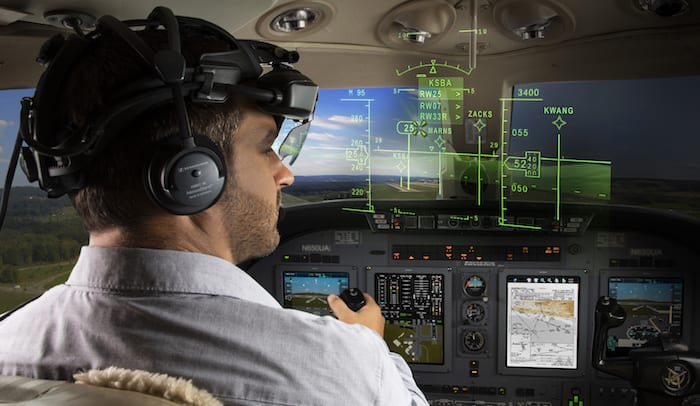
Head up Head Down display system. Photo courtesy of Universal Avionics
Elbit Systems unveiled its first new avionics technology since acquiring Universal Avionics at the National Business Aviation Association’s 2018 conference and exhibition, a wearable head-up display (HUD) with combined vision that lets pilots control their aircraft’s flight management system (FMS) with their eyes.
The “Head Up, Head Down” flight deck system’s technology combines Universal’s InSight cockpit display system, FMS and Elbit’s Skylens wearable HUD. It marks the first time an enhanced flight vision system (EFVS) will be introduced as a retrofit in the form of a HUD that will not require massive rewiring and upgrading of line-replaceable units. The aviation industry’s first application for the Sklylens was introduced for Leonardo’s commercial helicopter variants at the 2018 Heli-Expo exhibition in Las Vegas in March.
Elbit completed its acquisition of Universal in April, making it a subsidiary of the Israeli aerospace and defense manufacturer while keeping the brand name in place. During a press conference at NBAA, Elbit Systems VP of Commercial Aviation Dror Yahav used a flight simulator to provide a live demonstration of the system super-positioning FMS information on the pilot’s outside-the-cockpit view of the real world.
The demonstration provided a simulated approach into Santa Barbara airport, where the pilot was able to scan the environment, select a runway and approach fix using his eyes.
Simultaneously, the FMS processed information based on the pilot’s eye movements, automatically updating the navigation data to provide an approach path. Elbit and Universal also included functionality where the pilot can combine the flight deck system’s synthetic vision database with the HUD’s infrared EFVS camera to populate the real-world view with surrounding terrain information.
Yahav said the combination of Universal’s flight management computer and Elbit’s vision system and camera functionality allows them to “bring the augmented reality trend into the aviation world so operators can receive full flight management information generated by the FMS, superimposed on the real world.”
“We’re enabling pilots to do everything that they perform manually with the FMS, now with their eyes,” said Yahav.
Pilots using the fully integrated version of the system are also able to program and update their flight path, change their selected runway and waypoint programming simply by looking at the information and selecting what they need with their eyes. The Skylens is also approved to be operated to the most updated ruling released by the FAA under FAR 91.176.
That ruling allows pilots to descend below decision altitude/decision height or minimum descent altitude (MDA) in low visibilities on a greater number of approach procedure types. It also allows pilots to land without the use of natural vision.
Elbit expects to have the system certified and available for retrofit applications by the end of the year. Cockpits that are already equipped with Universal’s InSight flight deck can upgrade to the new system with an FMS software upgrade that enables the Skylens integration.
Universal Avionics CEO Paul DeHerrera told Avionics International that ADS-B In information can also be integrated into the system.
“We’re looking at several new features for the system in the future. We can put a triangle around an ADS-B-equipped aircraft and show its flight path to the pilot in the air, for example, or its position on the runway once the aircraft has landed,” said DeHerrera. “We’re just getting started. This is going to be an increasingly advanced system as we move forward.”